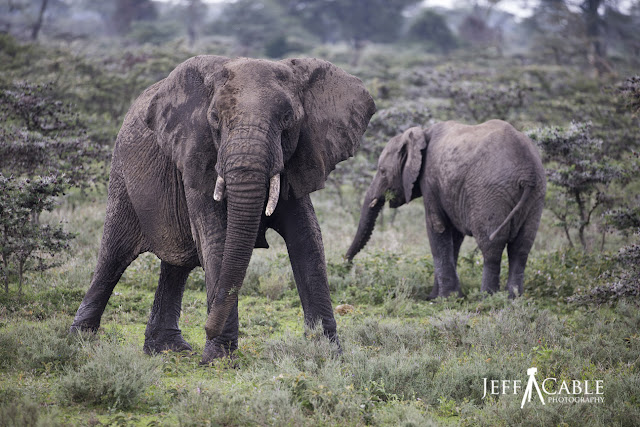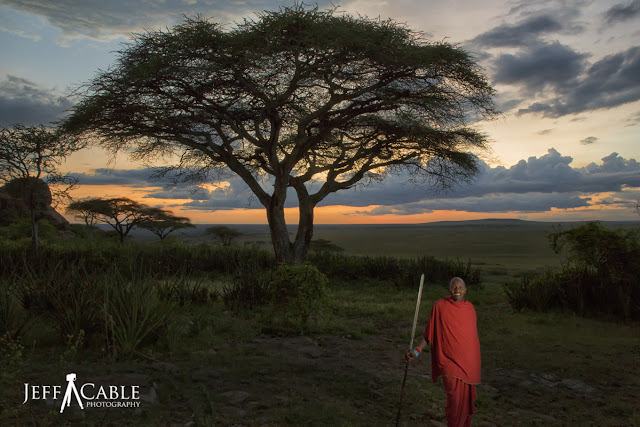When I came back from our Tanzanian safari last year, I wrote a note to myself to write a blog post to help others prepare for a safari of their own. Not only to help with the photo equipment, but also to help with the clothing and other gear to take with you.
So...if you are lucky enough to be going on safari in the near future, and wondering what to take with you, I hope that this blog post helps you in that planning process. If you don't have a trip planned, check out our
upcoming photos tours.
Since I am a photographer and the camera equipment is probably more important than my clothing, I will start with that.
Cameras
I would really recommend taking a DSLR camera with you on a trip like this. Not just one, but actually two of them. There are two reasons why you will want two DSLR cameras:
1. It can be dusty on safari and changing lenses is not a great idea, since the sensor of the camera can get very dirty. I like to keep on camera with a long lens and one with a wide lens.
2. You will want a backup camera just in case something were to happen to your primary DSLR. You would not want to be on your photographic trip of a lifetime and not be able to take great photos!
If you do not own two DSLR cameras (which is probably the case), I would recommend renting the second camera to take with you.
This year I will be bringing 3 cameras with me:
* The
Canon 1DX Mark II
* The
Canon 5D Mark IV
* The
Canon 7D Mark II (crop sensor for a little more reach)
Lenses
I just mentioned that I like to have one camera with a long lens and one with a wide lens. At which point, you might have been thinking "yeah well...what lenses do you recommend?"
Here are the two lenses which I rely on must heavily during our two weeks on safari:
* The
Canon 100-400mm II zoom lens. This lens is very sharp and gives me a great focal range for photographing wildlife near and far. There have been very few times when I needed more than 400mm on my full frame camera to get the shots I desired. Looking back at the photos from my last safari, most of them were captured at a range of 300mm.
 |
| This image was captured at 320mm |
* The
Canon 24-70mm II lens. For those people who have never been on a safari before, they most likely think that all the wildlife is very far from them, but this is hardly the case. There are many times when the animals are right up to your vehicle. For these times, it is great to have a wide lens available. And, of course, there are many majestic landscape photo opportunities that are best suited for a wide lens.
 |
| This image was taken at 24mm |
If you have the room and the back strength to bring more gear, I might also suggest the following lenses:
* The
Canon 16-35mm III lens for even wider photos. On my last safari, I used this lens for wide landscapes and sunset photos.
* The
Canon 1.4x Tele Converter. This adaptor can be added to the 100-400mm lens in those times when 400mm is just not enough. The 1.4x Tele Converter is small and easy to pack with you.
Photo Accessories
Here are the photo accessories that you will want to take with you, to make sure you are prepared for any situation:
*
Memory Cards - I would recommend taking along a bunch of memory cards with you. This is not the type of trip where you will shoot one or two photos per hour. You are going to take a LOT of photos. Don't go on safari with a couple of 32GB cards and think that you have enough memory. I would not go on safari with anything less than 200GB of memory. With that said, if you have good backup strategy, you can shoot to the same cards every day and be OK. Which leads us to the next item...
* Laptop computer - When I shoot a lot of photos, I love getting back to my laptop to download and see what I got. I usually try to cull through the images to dispose of duplicate and reject images, and then rank my favorites.
* Hard drives and SSDs - As soon as I have gone through all my images from the day, I back up those photos to 3 different hard drives or solid state drives (SSDs). This usually includes the built-in drive on the
MacBook Pro 15" and two
WD Passport drives and/or
Lexar Portable SSDs. The Internet is not usually fast enough to upload favorites to a service like Dropbox, so you will need to rely on good backup drives on location. One I have these photos on 3 different drives, I am then OK to reformat my cards for the next day's shoot.
* Extra batteries - I would recommend having two batteries for each camera you are taking with you. As I mentioned before, you will be shooting a lot of images and it is likely that one battery will not last you through the whole day. On our photo tours, each of our extended vehicles has power outlets in the vehicle, so it is not unusual for me to charge, my laptop, phone and batteries while we are out on safari. If not, make sure you recharge your batteries in the evening.
* Flash - I bring one
Canon flash unit with me, for those times when I want to fill flash my subjects, and for taking portraits of people. I used that flash in the photo above, to light the Masai tribesman.
* Sensor cleaner - Earlier, when I was talking about having two cameras, I touched on the dirty sensor issue. Unless you never change a lens or add a tele converter on your trip, there is a good chance that your sensor can get dirty. For that reason, I bring a
Visible Dust sensor cleaner with me and, if need be, clean the cameras inside my tent. Note: Do NOT change lenses on your cameras with the camera facing up. I switch lenses as quick as I can, and always keep the camera facing down so the dust will not fall into the exposed lens opening.
* Filters - I have the
Tiffen HT UV filters in front of all my lenses, mainly to protect them. The reason I use the HT filters is that they are super clear. I don't want to put bad glass in front of a great lens! The other filter that I bring on safari is the
Tiffen Circular Polarizing Filter for use during my landscape and water shots. It is the one filter that is difficult to "fake" in programs like Photoshop.
* Camera backpack - I bring all of my camera equipment in one large photo backpack. My choice is the
ThinkTank StreetWalker HardDrive. I love this backpack because it holds my camera gear, my 15" MacBook Pro, wallet, passport and more.
* Tripod - I did not use my
Gitzo travel tripod all that often on my last trip to Africa, but I did use it a couple of times to take night shots. I also used my tripod for long exposures at the hippo pond. I use this tripod and the
Acratech ball head.
* Camera strap - I never go anywhere without my
BlackRapid camera strap. The strap is not all that necessary when you are in the vehicle (which is the bulk of the time) but very handy when you are walking around. On our last photo tour, we had times when we visited a Masai village, walked through town, or hiked through the plains.
Clothing
Ask anyone who knows me, and they will tell you that I am much more knowledgeable about camera equipment than I am about clothing. But over the last couple of years I have learned a couple of things about dressing for safari. It is best to pack light, since most places have laundry service which is fast and inexpensive. Here is what I usually bring:
* Three pair of lightweight pants (2 of which have the pant legs which unzip and come off)
* Two pair of shorts
* Four lightweight shirts (long sleeve and short sleeve)
* 5 pair of underwear and socks
* A light jacket for the cool evenings
* Two hats - in case you lose one
* Two pair of shoes - I pack two pair since you may end up with a pair that get soaked or muddy and need a dry pair. I also like to leave a pair in Africa for the people who don't have good shoes.
If you have a Bass Pro Shop anywhere near you, I would recommend visiting that store for good quality and inexpensive clothing options.
Other stuff
There are some other things that you might want to bring with you on safari:
* Sunscreen - you will want this to protect from sunburn
* Bug spray - you may encounter mosquitos, flies and more...
* Meds - most people take malaria pills and other meds before, during and after a safari (depending on location - see a travel doctor before you leave)
* Noise cancelling headphones - I love these for long flights!
* Melatonin - this helps me sleep better and adjust to new time zones. I prefer the gummy versions.
* Cash - In Tanzania specifically, they take American currency and cash is king. I would take at least $300 in cash with you.
* International cell plan - If you are planning on using your mobile phone on your trip, check with your cellular carrier to get an International plan for voice, text and data.
If you are lucky enough to be taking a safari any time soon, I hope this helps you pack better, and get great photos to remember the trip!
Once again, if you are interested in going with me on one of our photo tours, you can find information on the upcoming trips
here.
__________________________________________________________________________
And also, remember that you and your friends can enter your email address at the top right of this blog to get an email any time I write a new blog post.
__________________________________________________________________________
If you are interested in purchasing ANY equipment, please click
here to go to B&H Photo, as I get a referral from them if you enter this way. It does not change the cost to you in any way, but it helps me keep this blog up and running.
__________________________________________________________________________































